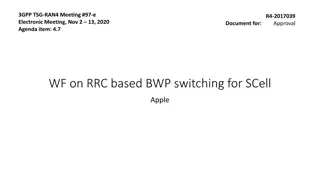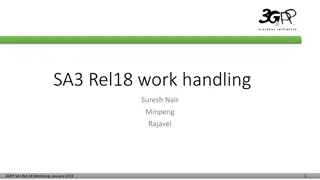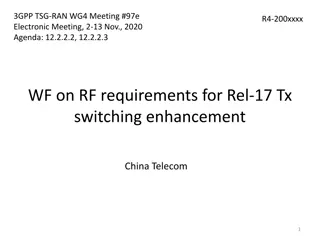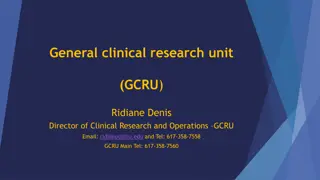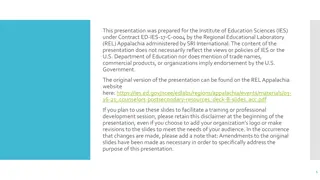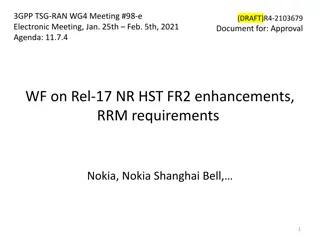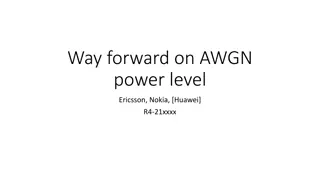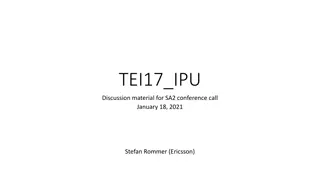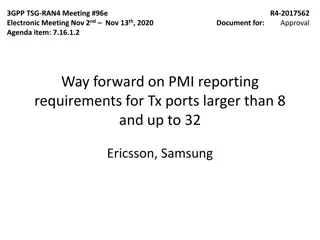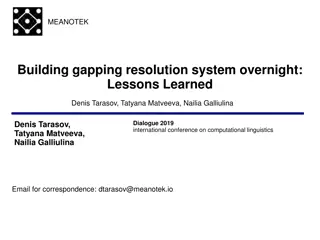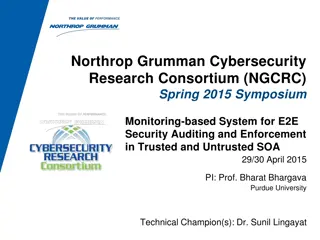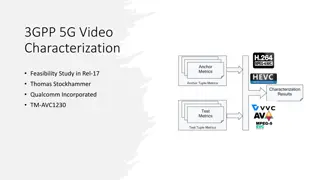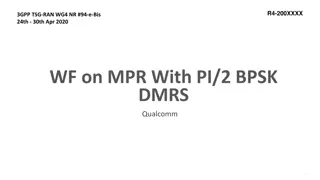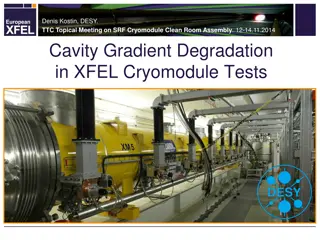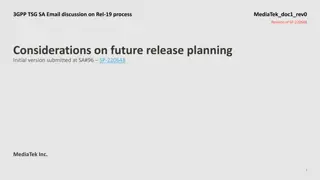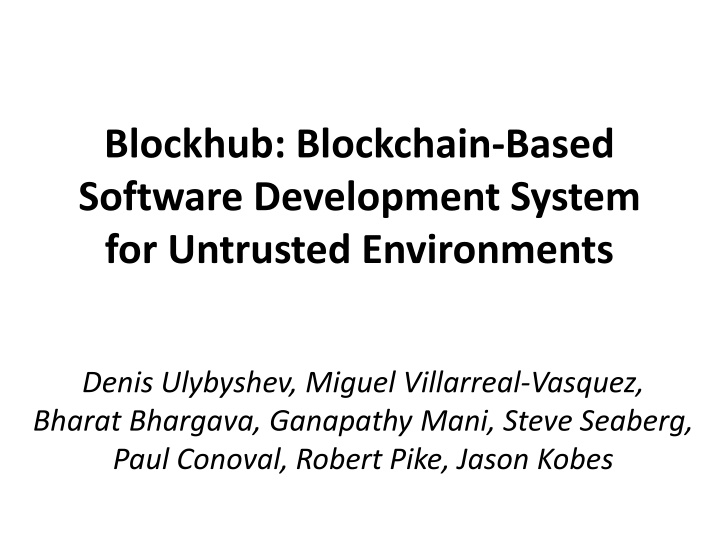
Blockchain-Based Software Development for Secure Cross-Domain Environments
Explore "Blockhub," a blockchain-based software development system designed for untrusted environments. Addressing the need for fine-grained access control, data integrity, and secure cross-domain exchange, this system utilizes blockchain technology to ensure tamper-resistance and non-repudiation of software interactions. Discover the core design, motivation, problem statement, and the use of blockchain for software integrity in this comprehensive outline.
Download Presentation

Please find below an Image/Link to download the presentation.
The content on the website is provided AS IS for your information and personal use only. It may not be sold, licensed, or shared on other websites without obtaining consent from the author. If you encounter any issues during the download, it is possible that the publisher has removed the file from their server.
You are allowed to download the files provided on this website for personal or commercial use, subject to the condition that they are used lawfully. All files are the property of their respective owners.
The content on the website is provided AS IS for your information and personal use only. It may not be sold, licensed, or shared on other websites without obtaining consent from the author.
E N D
Presentation Transcript
Blockhub: Blockchain-Based Software Development System for Untrusted Environments Denis Ulybyshev, Miguel Villarreal-Vasquez, Bharat Bhargava, Ganapathy Mani, Steve Seaberg, Paul Conoval, Robert Pike, Jason Kobes
Outline 1. Problem Statement 2. Motivation 3. Core Design 3.1. Software Bundle 3.2. Blockhub Architecture 4. Evaluation 5. Conclusions 6. Future Work 2
Problem Statement Design a framework for cross-domain secure software development that provides: Fine-grained role- and attribute-based access control Integrity of provenance data Interactions between services are logged Log records can not be corrupted Data/software confidentiality and integrity Data/software spillage detection 3
Blockchain Overview Blockchain is a file shared by network participants This file stores logs (transactions) organized in blocks Each new block is linked to the previous one Any log record in the Blockchain can be cryptographically verified any time in the future Different types of logs: Transaction Logs, Pieces of Code (Smart Contracts / Chaincodes) Transactions can not be repudiated 4
Motivation: secure platform for software development Provide secure cross-domain exchange of Data / Software Modules (SMs), enabling software tracking and auditing 5
Core Design Software Bundle (SB) contains: Sensitive data: Encrypted data items or software modules Access Control Policies: Manage SB interaction with services and hosts Metadata describes SB Policy Enforcement Engine Enforces policies specified in SB Provides tamper-resistance of SB [4] 6
Core Design Ideas Extend Active Bundle [1], [2], [3] concept to store software modules (source code/ binary executables), in addition to data Record provenance data to investigate software spillages Use blockchain-based technology to guarantee integrity of provenance data for system with multiple untrusted writers Every software access/ transfer/ update is registered in a blockchain network and recorded in the public ledger Every software access/ transfer/ update is non-repudiatable and can be verified any time in the future 7
Attribute-Based and Role-Based Software Dissemination Source Code ACCESSIBLE CODE Browser s Crypto Level: High Authentication Method: Fingerprint Client s device: Desktop Source network: Corporate Intranet Role: Team Leader AUTHENTICATED CLIENT Browser s Crypto Level: Low Authentication Method: Password Client s device: Mobile Source network: Unknown Role: Junior Developer Source Code AUTHENTICATED CLIENT INACCESSIBLE CODE 1 ACCESSIBLE CODE INACCESSIBLE CODE 2 8
Software Bundle Key is not stored inside SB [4] Separate symmetric key is used for each separate data subset Tamper-resistance is guaranteed di Aggregation{di} (Execution info; Digest(SB Modules); Resources) Ki Key DECki (di) Derivation Module Aggregation{di} ( Tampered ( Execution info; Digest(SB Modules); Resources)) wrong di K i Key DECk i (di) Derivation Module 9
Blockhub: Core Design Integrate WAXEDPRUNE [7] project into blockchain-based framework to provide additional features: (a)role-based access control (b)detection/prevention of data/software spillages made by insiders (c) attribute-based access control, attributes include: (c1) trust level of network nodes (c2) context (e.g. normal vs. emergency) (c3) authentication method (e.g. password-based vs. fingerprint) (c4) cryptographic capabilities of network node 10
Blockchub: blockchain-based platform BlockHub can be used for: 1. Tracking and control of software components that are shared across multiple security domains. 2. Automating the export auditing and tracking processes. 3. Cross-domain dissemination of encrypted software modules using role- and attribute-based access control. 4. Licensing provenance of deployed software components. 5. Enabling software supply chain that is tamper resistant. 6. Software spillage remediation. 11
Blockchub Architecture X and Y share software via smart contracts running in blockchain network Every request is logged in the blockchain s distributed ledger Software stored in form of Software Bundles (SB) Software is transferred if authorization has been granted by both smart contract (first) and policy enforcement engine of the corresponding SB Any transaction, i.e. software access/update can be verified any time in the future 13
Experiment Objectives: (1)Test verifiability of the data/software exchange transactions in blockchain-based framework; (2) measure performance overhead. Input: 3web services(in NodeJS-based framework) which exchange sample data/software modules. Output parameters: (1)verifiabletransaction records (provenance data); (2) Transaction latency. Experimental setup:(1) data/software request goes through IBM Hyperledger Fabric 1.0.x blockchain network [5] (codebase taken from [7] ). (2) if permitted by smart contracts, request evaluated by Policy Enforcement Engine of SB (WaxedPrune project [7] ) 14
Blockchub Evaluation Experimental Setup: IBM Hyperledger Fabric ver 1.0.x [5], Marbles open-source project [6] 15
Conclusions Blockchain-based framework Blockhub can be used for secure collaborative cross-domain software development Blockhub supports: Role-based and attribute-based access control Data/software spillage detection Confidentiality and integrity of data and software modules Integrity of provenance data Overall Performance needs to be improved Overhead, imposed by Waxedprune, does not exceed 0.8% 16
Future Work Performance: (a) Transaction latency in IBM Hyperledger Fabric blockchain platform (ver 1.0.x) is about 6 seconds (b) Overhead on log verification phase when the chain is large (a great amount of blocks) => verifiers have to compute many hash functions Solution: (a) Modify transaction verification process at Endorsers (b) Explore other blockchain-based platforms (c) Implement basic blockchain-based functionality from the scratch without using existing platforms 17
Future Work Failure Recovery Need to maintain consistency in mobile environment with intermittent connectivity Need quantification of performance parameters after a varying period of connectivity breakdown Need to determine how much bandwidth and resources are needed to make network nodes consistent (or current) 18
References [1] L. Ben Othmane and L. Lilien, Protecting privacy in sensitive data dissemination with active bundles, 7-th Annual Conf. on Privacy, Security and Trust (PST 2009), Saint John, New Brunswick, Canada, Aug. 2009, pp. 202-213 [2] L. Lilien and B. Bhargava, A scheme for privacy-preserving data dissemination, IEEE Trans. on Systems, Man and Cybernetics, Part A: Systems and Humans, vol. 36(3), May 2006, pp. 503-506. [3] L. B. Othmane, Active bundles for protecting confidentiality of sensitive data throughout their lifecycle, PhD thesis, Western Michigan University, 2010. [4] R. Ranchal, Cross-domain data dissemination and policy enforcement, PhD Thesis, Purdue University, Jun. 2015 [5] IBM Blockchain 101: Quick-start guide for developers, 2016. Available: https://www.ibm.com/developerworks/cloud/library/cl-ibm-blockchain-101-quick- start-guide-for-developers-bluemix-trs/index.html, accessed: May 2018 [6] Marbles Demo, Available: https://github.com/IBM-Blockchain/marbles, accessed: May 2018 [7] D. Ulybyshev, B. Bhargava, M. Villarreal-Vasquez, D. Steiner, L. Li, J. Kobes, H. Halpin, R. Ranchal, A. Oqab-Alsalem, Privacy-Preserving Data Dissemination in Untrusted Cloud , IEEE CLOUD 2017, pp. 770- 773. 19



